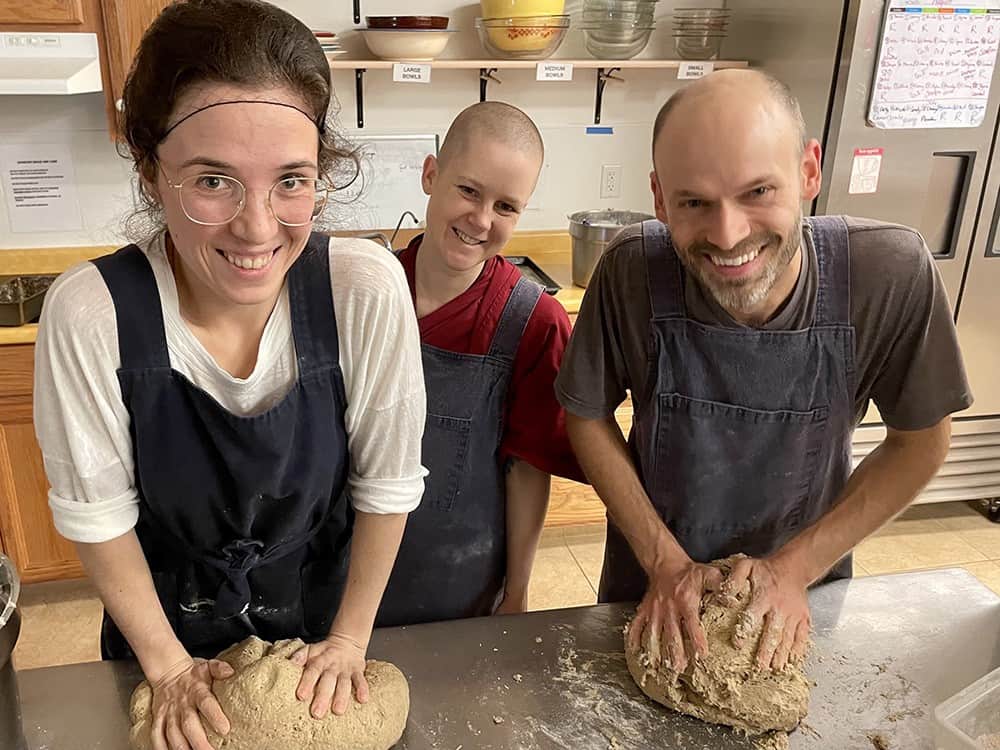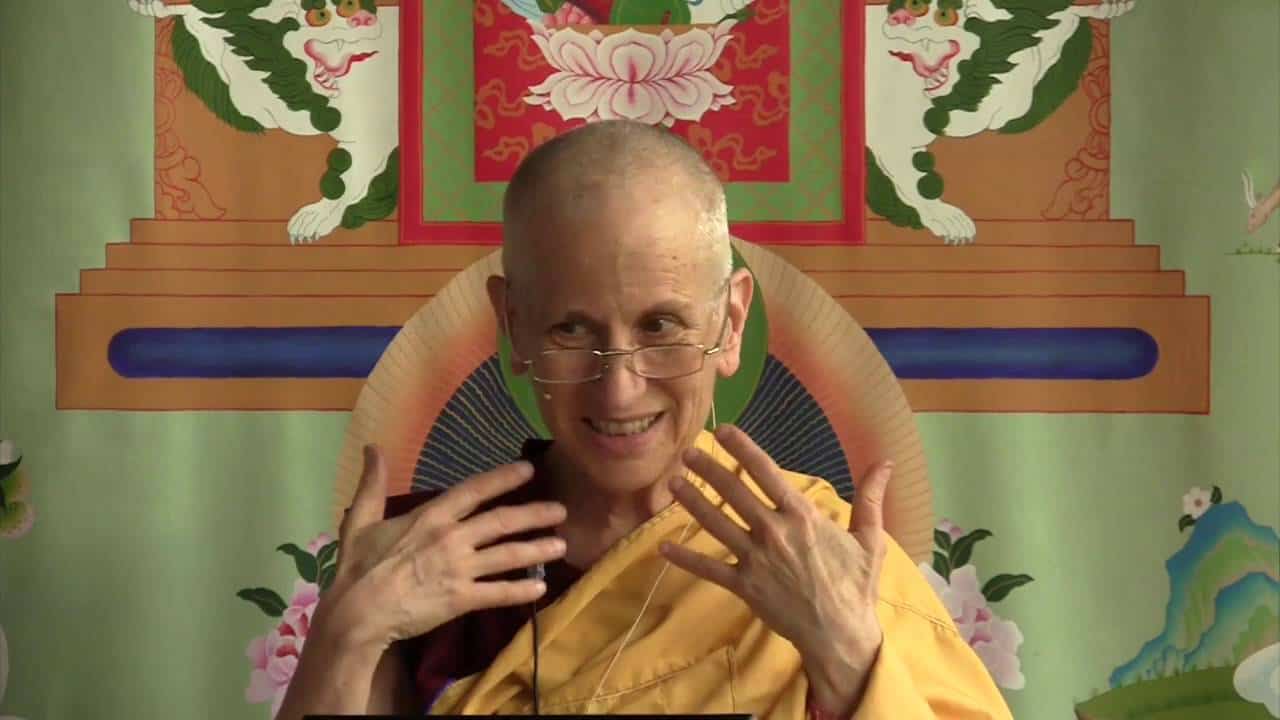Homage to the Three Jewels
Part of a series of short talks about the meaning and purpose of the food offering prayers that are recited daily before lunch at Sravasti Abbey.
- An explanation of the homage verses
- The qualities of the Three Jewels
- How reciting homage verses helps our own minds
We’ll continue on talking about food and eating from a Buddhist perspective. We talked about motivation, we talked about preparing to eat and the five reflections from the Chinese tradition. Now we’re going to go into the verses that we usually chant before we eat that are taken from the Tibetan Buddhist tradition.
These start with three verses that are paying homage to the Buddha, Dharma, and Sangha, then an offering verse, and then a couple of dedication verses. We say them all before we eat.
The first one of the ones we chant starts with an homage to the Buddha.
Great compassionate Protector,
All-knowing Teacher,
Field of merit and good qualities vast as an ocean—
To the Tathagata, I bow.
We’re paying homage to the Buddha and we’re seeing him as a great, compassionate protector and all-knowing teacher. This is reminding me a little bit of Dignaga prostration to the Buddha where he cites different qualities that make a buddha a valid guide on the path. But because of the Buddha’s great compassion then that motivated him to realize emptiness and to gain the teachings on emptiness so that he could become the sugata, or the tathagata himself, and in that way be able to teach sentient beings and protect them.
The way the Buddha protects us is no by standing guard or building walls but by teaching us the Dharma. Another word for the Dharma actually is “preventative measures.” It protects or prevents us from suffering. The way the Buddha protects us is helping us learn how to protect our own minds from letting the afflictions arise and then having the afflictions create the karma that creates rebirth and unpleasant experiences.
He’s an “all-knowing teacher.” The Buddha knows all that exists. His Holiness talks about this in an interesting way. He says the very nature of the mind is clarity and cognisance, the very nature of the mind is its ability to reflect and engage in objects. That’s just the nature of the mind. So our inability to see things is due to different obstacles. Sometimes they may be physical obstacles: we can’t see what’s on the other side of the wall. Other times they’re obstacles due to our consciousness being clouded with the afflictive obscurations and the cognitive obscurations which prevent us from seeing things. The Buddha’s removed those two kinds of obscurations and so is all-knowing.
The benefit of being all-knowing is not so that you know the numbers to get the ticket for the lottery. The benefit of being all-knowing is so that you know the karma and dispositions and tendencies of different sentient beings and with that knowledge then you know how to guide them in the most effective way.
He’s the field of merit and good qualities vast as an ocean. Having abandoned everything there is to abandon, having realized everything there is to realize then his mind is vast like an ocean in terms of good qualities. And he becomes a merit field because of these good qualities. The virtuous actions that we do in relationship to the Buddha become extremely potent because of his spiritual attainments. In the same that if we commit negativities against the Buddha it becomes very potent because of his spiritual attainments. Here of course we’re praising the Buddha and so it creates a lot of virtue.
It helps our minds when we say verses of homage like this. It makes us think of the Buddha’s good qualities, and when we do that then of course we want to develop those good qualities, we see the potential to do so in our own minds, and then that gives us a whole new vision for our lives. Then the meaning of your life isn’t just, well, let’s see if I can learn this particular skill so I can get a good job. It’s, wow, I can become a fully awakened buddha and be of great benefit to sentient beings. And by the very nature of my mind there’s the possibility to do so. That’s something I can do in my life. Just our whole image of ourselves and the meaning of our lives completely expands immensely just by contemplating this kind of verse and what we’re talking about in it.
Then the next verse:
Through purity, freeing from attachment,
Through virtue, freeing from the lower realms,
Unique, supreme ultimate reality—
To the Dharma that is peace, I bow.
That’s paying homage to the Dharma. The Dharma Jewel, the real Dharma refuge, is the last two noble truths: true cessations and true paths. When we actualize those in our mind then our mind is liberated. The real liberating force and the real liberation is something that exists in here (our heart), it’s not something that we get from outside and we paste on ourselves.
The first two lines are talking about the true path. “Through purity freeing from attachment.” That’s talking about the wisdom that realizes emptiness. By purity it means the absence of inherent existence. “Through purity freeing from attachment….” Through realizing emptiness then we cut craving (craving being the chief thing that makes us take rebirth in samsara), in addition, of course, to ignorance, which is the root of samsara. Attachment refers to craving here. By the realization of emptiness we’re able to cut the root of samsara and stop all rebirths all together.
“Through virtue freeing from the lower realms.” Through the true paths, as we create virtue, and even before we’re able to actualize the actual true paths, through our own virtue we stop the cause for being reborn in the lower realms. It’s said when you get to the second stage of the path of preparation then you’re no longer reborn in the lower realms. Although it doesn’t become incredibly definite until the path of seeing. Still, before that, that’s pretty good, isn’t it? Through accumulating so much virtue and stopping the nonvirtue then we stop creating the cause of lower rebirth, which already is a huge relief in samsara, but the real importance of stopping lower rebirth is that then we will be able to have a series of high rebirths, which Nagarjuna reminds us we need in order to gain the wisdom realizing emptiness and attain actual liberation.
“Unique supreme ultimate reality, to the Dharma that is peace I bow.” That’s talking about true cessations, the other part of the Dharma refuge. “Unique supreme ultimate reality,” that’s the emptiness of inherent existence of the mind that has eliminated all the afflictions, or that has eliminated all of the cognitive obscurations, too. The emptiness of that mind (or sometimes they say the purified aspect of the emptiness of the mind that has eliminated the afflictions or the cognitive obscurations)…. What that’s emphasizing is that emptiness is nirvana. The true cessations are a type of emptiness. They’re the emptiness of the mind that has eliminated those afflictions or cognitive obscurations.
Then, “to the Dharma that is peace I bow.” Here it’s talking about nirvana. Or, for Mahayana practitioners non-abiding nirvana or buddhahood. Nirvana is a state of peace that’s free from the obscurations. Peace is actually a synonym for nirvana.
So, in our youth, we want peace [gives peace sign]. What kind of peace do we want? External peace? Or internal peace? The external peace doesn’t come without the internal peace. So, paying homage to the Dharma.
Having freed themselves showing the path to freedom, too,
well established in the trainings.
The holy field endowed with good qualities,
to the Sangha I bow.
Here the Sangha Jewel are aryas. That can be one person, a lay person or an ordained person who has realized emptiness directly, non-conceptually. In other words, at the path of seeing. That can apply to any of the three vehicles: hearer, solitary realizer, or bodhisattva vehicle.
“Having freed themselves.” By the time you get to the path of seeing, or definitely by the time you get to arhatship, at least the path of seeing, you’ve freed yourself from uncontrolled rebirth in samsara. You’re not out of samsara but you’re not going to be taking rebirth completely under the control of affliction, so you’ve freed yourself in that way. By having done that then they can show the way to freedom to others by teaching others the path accurately from their own experience. Also acting as a good example of someone who practices the path. They are practicing the three higher trainings of ethics, concentration, and wisdom, and in that way through their example and through their teachings lead the rest of us.
“Well established in the trainings.” That’s why I say I never here the (plural “s”) when people are reciting this verse. The “s” is very important. It’s speaking of the three higher trainings (emphasize plural). If you just say, “Well established in the training (singular),” then you’re missing something. What training are you well established in? The Sangha is well established in the three trainings, so saying “trainings” is quite important. And then remembering higher training in ethical conduct, in concentration, and wisdom. They’re called the higher trainings because they’re done with a mind that has refuge in the Three Jewels, and with an aspiration for nirvana.
So, they’re well established in these trainings, they really have embodied them and integrated them in their mindstreams.
“The holy field endowed with good qualities.” Again, the Sangha is a field of merit for us, particularly the Arya Sangha because they have the realizations. The representative of the Arya Sangha is a community of four or more fully ordained beings. That may be included here when it says “the holy field endowed with good qualities.” The real holy field are the aryas, the sangha community is the representation of that. Still, when you make offerings to the sangha community then you create a lot of merit because it’s helping the Dharma to become rooted and grow and spread in the country. The sangha community is really important for that.
And here by sangha I mean the monastic community. Lay teachers are very important. Lay practitioners are very important. But the monastic community has a very special role in terms of inspiring people, protecting and preserving the teachings, and trying to embody them. So it becomes a field of merit in that way. Which of course is why we need to fulfill our part of the deal, otherwise that becomes frivolous talk.
Like I said, the real Sangha we take refuge in are the Aryas, because they’re the ones that are completely reliable, with virtuous motivation.
We start out by paying homage to the Three Jewels, those are the first three verses. Then next time we’ll talk about the actual offering verses and the dedication verses.
Venerable Thubten Chodron
Venerable Chodron emphasizes the practical application of Buddha’s teachings in our daily lives and is especially skilled at explaining them in ways easily understood and practiced by Westerners. She is well known for her warm, humorous, and lucid teachings. She was ordained as a Buddhist nun in 1977 by Kyabje Ling Rinpoche in Dharamsala, India, and in 1986 she received bhikshuni (full) ordination in Taiwan. Read her full bio.


